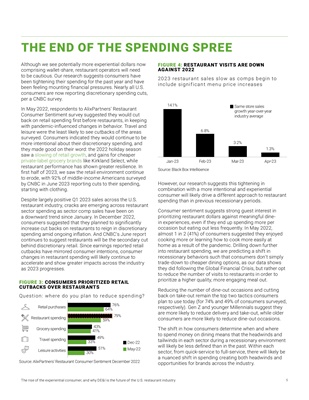
The rise of the experiential consumer, and why DE&I is the future of the U.S. restaurant industry 5
FIGURE 4: RESTAURANT VISITS ARE DOWN
AGAINST 2022
2023 restaurant sales slow as comps begin to
include significant menu price increases
Same store sales
growth year-over-year
industry average
14.1%
Jan-23
6.8%
Feb-23
3.2%
Mar-23
1.3%
Apr-23
Source: Black Box Intelligence
However, our research suggests this tightening in
combination with a more intentional and experiential
consumer will likely drive a different approach to restaurant
spending than in previous recessionary periods.
Consumer sentiment suggests strong guest interest in
prioritizing restaurant dollars against meaningful dinein
experiences, even if they end up spending more per
occasion but eating out less frequently. In May 2022,
almost 1 in 2 (41%) of consumers suggested they enjoyed
cooking more or learning how to cook more easily at
home as a result of the pandemic. Drilling down further
into restaurant spending, we are predicting a shift in
recessionary behaviors such that consumers don't simply
trade-down to cheaper dining options, as our data shows
they did following the Global Financial Crisis, but rather opt
to reduce the number of visits to restaurants in order to
prioritize a higher quality, more engaging meal out.
Reducing the number of dine-out occasions and cutting
back on take-out remain the top two tactics consumers
plan to use today (for 74% and 49% of consumers surveyed,
respectively). Gen Z and younger Millennials suggest they
are more likely to reduce delivery and take-out, while older
consumers are more likely to reduce dine-out occasions.
The shift in how consumers determine when and where
to spend money on dining means that the headwinds and
tailwinds in each sector during a recessionary environment
will likely be less defined than in the past. Within each
sector, from quick-service to full-service, there will likely be
a nuanced shift in spending creating both headwinds and
opportunities for brands across the industry.
THE END OF THE SPENDING SPREE
Although we see potentially more experiential dollars now
comprising wallet-share, restaurant operators will need
to be cautious. Our research suggests consumers have
been tightening their spending for the past year and have
been feeling mounting financial pressures. Nearly all U.S.
consumers are now reporting discretionary spending cuts,
per a CNBC survey.
In May 2022, respondents to AlixPartners' Restaurant
Consumer Sentiment survey suggested they would cut
back on retail spending first before restaurants, in keeping
with pandemic-influenced changes in behavior. Travel and
leisure were the least likely to see cutbacks of the areas
surveyed. Consumers indicated they would continue to be
more intentional about their discretionary spending, and
they made good on their word: the 2022 holiday season
saw a slowing of retail growth, and gains for cheaper
private-label grocery brands like Kirkland Select, while
restaurant performance has shown greater resilience. In
first half of 2023, we saw the retail environment continue
to erode, with 92% of middle-income Americans surveyed
by CNBC in June 2023 reporting cuts to their spending,
starting with clothing.
Despite largely positive Q1 2023 sales across the U.S.
restaurant industry, cracks are emerging across restaurant
sector spending as sector comp sales have been on
a downward trend since January. In December 2022,
consumers suggested that they planned to significantly
increase cut backs on restaurants to reign in discretionary
spending amid ongoing inflation. And CNBC's June report
continues to suggest restaurants will be the secondary cut
behind discretionary retail. Since earnings reported retail
cutbacks have mirrored consumer intentions, consumer
changes in restaurant spending will likely continue to
accelerate and show greater impacts across the industry
as 2023 progresses.
FIGURE 3: CONSUMERS PRIORITIZED RETAIL
CUTBACKS OVER RESTAURANTS
Question: where do you plan to reduce spending?
30%
33%
41% 59%
51%
49%
43%
79%
76%
Leisure activities
Travel spending
Grocery spending
Restaurant spending
Retail purchases
Source: AlixPartners' Restaurant Consumer Sentiment December 2022
64%
May-22
Dec-22